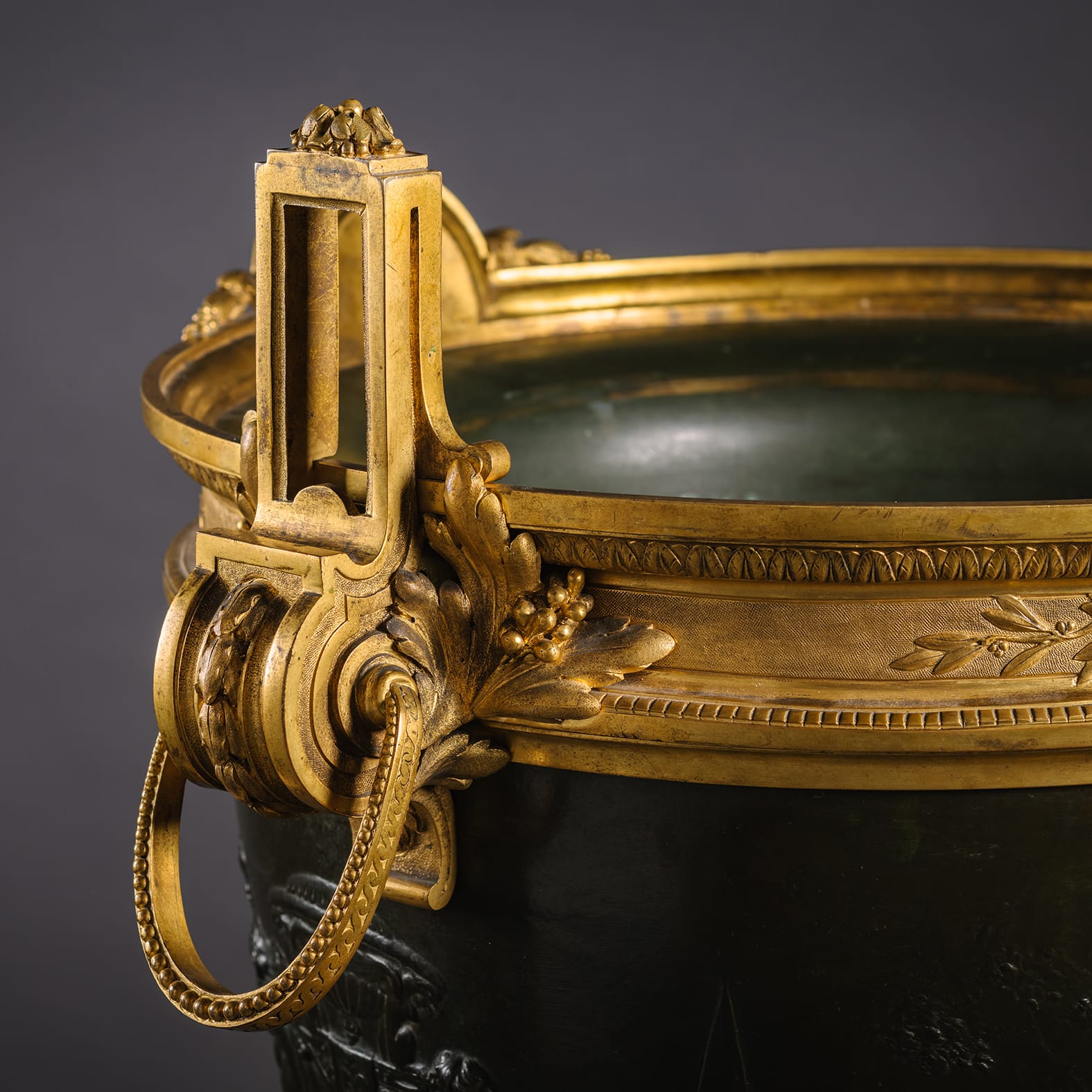After Claude Michel Clodion
A Large and Rare Gilt and Patinated Bronze Jardiniere or Monumental Wine Cooler
£65,000
A Large and Rare Gilt and Patinated Bronze Jardiniere or Monumental Wine Cooler. With upright scroll handles over a cylindrical body cast with scenes...
Dimensions
Height: 84 cm (34 in)Width: 61 cm (25 in)
Depth: 61 cm (25 in)
Description
A Large and Rare Gilt and Patinated Bronze Jardiniere or Monumental Wine Cooler.
With upright scroll handles over a cylindrical body cast with scenes of a bacchic procession and centred by Bacchus and Ariadne on a cheetah-drawn chariot, above a Greek key band with satyr masks suspending floral garlands. The gadrooned socle suspended by four scroll feet, on a shaped foot.
The sculptural panel depicts the triumph of Bacchus and Ariadne. The god of wine, is shown seated in his chariot revelled around by men, women, satyrs and putti. Ariadne lounges beside Bacchus whilst cupid hovers overhead holding a crown, symbolising their love. The procession continues around the body of the vase and to the reverse shows Silenus seated on the back of a donkey, as well as the three graces and satyrs carrying an incense burner.
The story of Bacchus and Ariadne from Ovid’s Metamorphoses tells how Ariadne, a princess from Crete, is abandoned on the Greek island of Naxos by her lover Theseus. She is discovered on the shore by the god Bacchus who fails in love with her at first sight and throws her jewelled crown into the sky to create a constellation, the Corona Borealis. Their wedding procession in a chariot drawn by cheetahs is a frenzy of wine, music and dance. The most celebrated representation of this seminal subject is Titian’s ‘Bacchus and Ariadne’ (1522–1523) in the National Gallery, London.

Titian (Tiziano Vecelli c. 1488-1576) ‘Bacchus and Ariadne’, 1522-23, National Gallery, London. Public Domain.
This charming and detailed composition is inspired by the production of Claude Michel, called Clodion (1738-1814), and his pupil Joseph-Charles Marin (1759–1834).

A terracotta plaque of the ‘The Triumph of Bacchus’ by Joseph-Charles Marin, circa 1790. (National Gallery of Canada).

A chromolithograph of a jasperware plaque by Josiah Wedgwood depicting ‘The Triumph of Bacchus and Ariadne’, circa 1780.
France, Circa 1890.
Date
Circa 1890
Origin
France
Medium
Patinated and Gilt-Bronze
The son-in-law of sculptor Augustin Pajou, Clodion, (Claude Michel), (1738-1814), trained in Paris in the workshops of his uncle and Jean-Baptiste Pigalle, the most successful sculptor of the time. After winning the Prix de Rome, he moved to Italy, sharing a studio with Jean-Antoine Houdon and studying antique, Renaissance, and Baroque sculpture.
In 1771 Clodion returned to Paris, where he continued to produce mostly in terracotta. He also worked with his brothers in other media, decorating objects such as candelabra, clocks, and vases. Drawing primarily from pagan antiquity, he created light-hearted terracotta sculptures that epitomised the Rococo style. Late in his life, when Neo-classical works were more popular, Clodion adjusted his style and worked on major public monuments in Paris.





















 Print
Print


